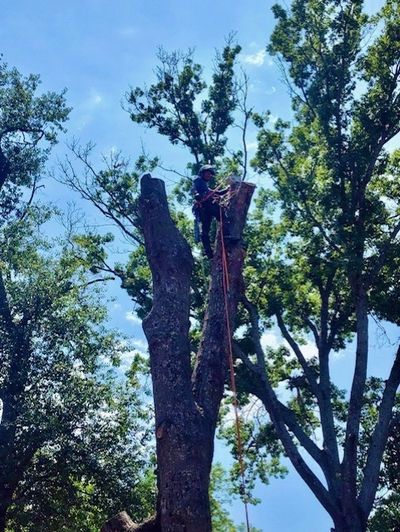Arboriculture professional tree services Call 469-819-4917
What is a Arborist? A professional trained in the cultivation, management, and study of individual trees generally in a landscape. Arborists generally focus on the health and safety of individual trees.
Tree Pruning
Pruning is a horticultural, arboricultural practice involving the selective removal of certain parts of a plant, such as branches, buds, or roots. The practice entails the target removal of diseased, damaged, non-productive, structurally unsound, or otherwise unwanted plant material.
In general, the smaller the branch is cut, the easier it is for a woody plant to compartmentalize the wound and thus limit the potential for pathogen intrusion and decay.
It is therefore preferable to make any necessary formative structural pruning cuts to young plants, rather than removing large, poorly placed branches from mature plants.
ISA (International Society of Arboriculture) Texas chapter member.
What are the benefits of pruning?
Pruning is one of best things you can do for your trees. A proper prune is both an investment in the long-term health of your plants and in the overall look and safety of your property.
When you trim your trees, you get all these benefits!
Say farewell to dead, broken or damaged branches.
Save your property from potential damage from fallen branches.
When you remove old branches, you give trees the green light to put out healthy, new growth.
Train trees to grow on your terms so that branches won’t hang over the roof or stretch into power lines.
Give trees a clean, polished look that elevates your whole landscape.
Set the tree up with a good foundation for long-term health.
What are the different types or methods of pruning?
Different tree goals call for different tree trimming methods.
Here’s a breakdown of the most common types:
- Reducing density removes limbs all the way back to their branch of origin. It’s a method used to free up a full canopy so that more sunlight can come through.
- Maintaining health is like fine-tuning a tree. Simple cuts are used to clear out dead, diseased, and damaged limbs to give the tree a polished look.
- Size management cuts reduce a tree’s height or width. This method typically shortens branches that are inching into utility lines or reduces a wide-spread tree.
- Structural (subordination) cuts could involve one or more of the above methods to improve a plant’s structure and long-term health.

Tree Health
Trunk Injections
Trees in the urban environment are often subject to a variety of conditions that affect their overall health such as insect, disease and nutritional deficiencies. With the knowledge and experience our on-staff arborists can provide the appropriate solutions to keep trees healthy.
Chemicals can be applied to trees to control damaging insects, diseases or nutitional deficiencies and in many cases, plant health care chemicals applied properly can help restore and maintain the tree’s health. Chemicals may be applied through tree trunk injections, soil application or spraying.

Hazards Removal
The importance of removal of damaged and diseased limbs/trees includes:
Safety: Removing hazardous or unstable trees and limbs can prevent accidents and property damage.
Health: Eliminating diseased trees and limbs helps prevent the spread of illness to other plants.
Space: Clearing trees creates room for new projects or structures.
Aesthetics: Tree removal can improve the overall appearance of your property.
Environmental: It contributes to the health of your landscape and outdoor environment.

